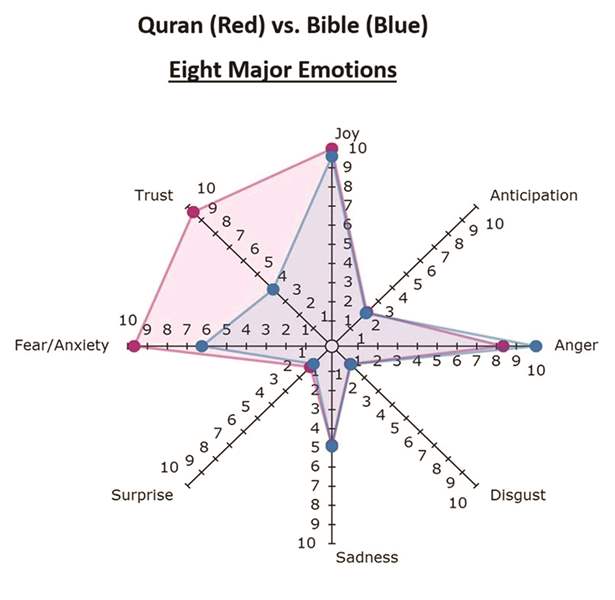
RELIGION
Bible, Qur’an, and violence computerized
Software uses Scripture to show what text analytics can do
2/6/2016
Graph: OdinText’s results for differences of eight emotions for the Bible’s Old and New Testaments (blue) and Qur’an (red). Tom H. C. Anderson used OdinText to analyze to examine scriptural content.

Graph: OdinText’s results for differences of eight emotions for the Bible’s Old and New Testaments (blue) and Qur’an (red). Tom H. C. Anderson used OdinText to analyze to examine scriptural content.
Tom H. C. Anderson is a numbers guy. He developed a software platform called OdinText, a way to conduct statistical and math-based research using words and phrases. That's called text analytics.
There's nothing inherently religious about Mr. Anderson's work, but he turned to Scripture to show the range of what OdinText can do, to go beyond the marketing research that is the standard for the Fortune 1000 companies and marketing businesses that make up OdinText's clientele.
Mr. Anderson, 44, of Stamford, Conn., is a former senior analyst for NFO Worldwide, Inc., a market-research firm that, when it was founded in Toledo in 1946, was called National Family Opinion.
He started OdinText in 2015 after developing the platform at his Anderson Analytics marketing research firm. For the blog on the odintext.com website, Mr. Anderson wanted to demonstrate his product by using something other than the typical text analysis data on customers generated from “call center logs, emails; often it's survey data. It could be social media data,” he said in a telephone interview.
Mr. Anderson decided to find out whether the Bible or the Qur'an is more violent. “It was partly just the idea of being able to analyze data that's been around for so long,” he said.
Scholars had taken different approaches, and he wanted to see what OdinText would produce in using natural language processing technology to analyze the Old Testament to represent the Hebrews, the New Testament for Christians, and the Qur'an for Muslims.
He wrote in the blog, “The project was inspired by the ongoing public debate around whether or not terrorism connected with Islamic fundamentalism reflects something inherently and distinctly violent about Islam compared to other major religions.”
He put plenty of qualifiers in his report to make the point that this was for curiosity, not ranking religions, and he did not intend to offend. This was primarily a software demonstration, so he designed a “cursory view of [the] three texts” that would lean toward objective and nonbiased general information, not the detail that OdinText could give with extensive data mining.

Tom H. C. Anderson
The OdinText exercise didn’t take long. On Jan. 17, he entered the complete text of English translations of the Old Testament, the New Testament, and the Qur’an into OdinText — a combined file of roughly 886,000 words in about 37,000 verses. He set up the parameters, and then he clicked “Next.” Just less than one minute, 45 seconds later, the three Scriptures had been “read” and he had instant results.
Among the analysis findings that Mr. Anderson reported Jan. 20, 21, and 22 in the blog are that the Old Testament is the most violent, not the Qur’an. The Islamic text is actually the least violent. Terms for killing and destruction were in 2.1 percent of the Qur’an, 2.8 percent of the New Testament, and 5.3 percent of the Old Testament.
He found “that the Old Testament is the ‘Angriest’ (including most mentions of ‘Disgust’); it also contains the least amount of ‘Joy,’” Mr. Anderson states in the blog.
“Love,” in contrast, takes up 3 percent of the New Testament, 1.9 percent of the Old Testament, and 1.26 percent of the Qur’an.
“Forgiveness” and “grace” are much more strongly in the Islamic holy book, 6.33 percent in the Qur’an, compared to 2.9 percent in the New Testament and 0.7 percent in the Old Testament.
“Personally,” Mr. Anderson said in the blog, “I’ll admit that I was a bit surprised that the concept of ‘Mercy’ was most prevalent in the Qur’an; I expected that the New Testament would rank highest there, as it did in the concept of ‘Love.’”
Could Mercy and Muhammad be something to ponder during this year of the Roman Catholic Extraordinary Jubilee of Mercy?
“I’ll leave it up to others to interpret or go further [with the analysis],” Mr. Anderson told me. “I think a theologian or somebody getting their PhD in literature could spend a lot of time going further. And geopolitics; obviously, there’s a lot of different disciplines that cross there.”
Now, about that company name. The Norse religion is not Mr. Anderson’s faith. He is originally from Scandinavia, and the story of Odin inspires him.
“Odin’s the key god in the Norse pantheon who was responsible for wisdom and knowledge,” he said. “He had two ravens who scoured the earth for information, gave up one eye for knowledge, and so forth. That’s technically what our clients are doing.
“But I found it kind of ironic [for the study], the idea of Odin reading the Bible and the Qur’an in under two minutes.”
Wisdom and knowledge rarely appear in such a short time.
Contact TK Barger @ tkbarger@theblade.com, 419-724-6278 or on Twitter @TK_Barger.